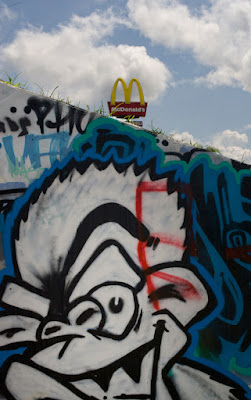We are truly never alone. Nor are we truly ever without.
Wherever we are there is always a sense of presence, a proximity to something else, another human, the company of another animal, the structures that make us human and those that do not. We feel a part of and never apart from the natural world and its diversity and the unnatural world and its complexity. We breathe its air, walk its terrain, swim its oceans, climb its trees, occupy its food chain and contribute to its existence. We also add to it with structures and destruction. There is no escape. Gravity takes care of that.
When we photograph we search for that connectedness. We look into the landscape to find its beauty. We want it to be part of us as if the feelings it imposes will transform us. We hunt the flora and fauna and see ourselves in their behaviour. Their beauty is ours to capture. Our camera scans the seas and sky for signs of life and to verify our existence. I am here. This is what I see.
But what of the space in between, the emptiness, the void that fills the gaps in this connectedness we all seek. Lord Rutherford pronounced: 'There is only two truths: atoms and space; the rest is mere conjecture.' According to modern cosmological theory, Rutherford might have been unaware of a few things but at least he was heading in the right direction.
What we photograph, in Rutherford's terms, is the atoms. They make up the 'things' we seek, the objects of our attention, the focal point and something for our auto-focus to align to. We fill our frame with atoms and molecules. We compose based on Form, the form of solids, liquids and gaseous vapours. Edward Weston suggested Form was everything in a photograph. He, like all of us, have a great attachment to the 'solidarity' of the Universe. Even in the vastness of Space we seek the stars and planets and use them to define its existence.
As I learnt to see as a photographer I became more and more aware of the stuff between the Form, the emptiness that edged to the surfaces and textures of my subjects. This nothingness began to grow in importance as a child becomes aware of the bareness of a crib or a surfer grasps the vastness of the ocean as he stares at the horizon. I wanted to photograph this abyss, this gaping hole that pushed against the frame and squeezed the 'things' from my view.
How do I photograph nothing? Other photographers described this void as 'negative space' as if it took away from the content, as though it meant 'less than' or a subtraction, almost an annoyance that persisted, like a whining child who just won't go away. In an effort to deal with this aggravation they began to use it as a means of visually describing content. It was used to 'divert the eyes' or outline the form or fill the frame as if it was a half empty bowl and you didn't want the contents to be discarded so it was easier to fill the container with whatever was available.
Now, most of the time it worked. We never notice. We are told it was OK the do this. After all, who in their right mind would want to make 'emptiness' a subject for portrayal. Stare at nothing? Who does that? Do we look at a blank wall and wonder at its beauty? Do we stare blankly into the distance and picture its content as interesting and exciting? Would we read a blank page or drink from an empty vessel or breath the contents of a vacuum?
Then I saw it! Brice Marden's 'The Dylan Painting'. You would need to be there. It was what I would image it is like standing on the top of Mt Everest and realising you were on the edge of it all and the rest was space; empty, hollow, endless space. And you could do what you like with it.
So begun my plight. Finding the space and photographing it. It easy enough to find, or so you'd think. Its everywhere. It fills the sky, it holds the ceiling of a cathedral, it keeps me at distance from my foes and it brings me close to my loved ones. How wonderful this space is. It occupies office blocks, streets, rooms, my backyard, the glass I hold and the place behind my mirror. It creeps into every crevasse and fills it with visual splendor. It has no colour, no texture, no form, no properties of its own but it gives life to all it encompasses. We can look into it, or out of it, be in it, on it, under it, surrounded by it or surround it. And like Gravity, it spreads all the way to the edge of the Universe and then it starts all over again, only to return and fill our lives with magic once more.
 |
| Still Life - Space and Roses |
 |
| Walking Space |
 |
| Breathing Space |
 |
| Finding Space |
 |
| Office Space |
 |
| Floor Space |
'There's a space there. Can you put something in it?'
'It really annoys me when people leave spaces!'
'How much space have I got here. I want to fill it.'
'Oh, look. A space. I'm going to put my big fat arse there. Who needs space?'
The next time you see some space, call me. I might just be able to capture it before it disappears.
























